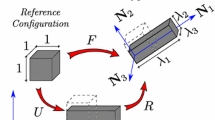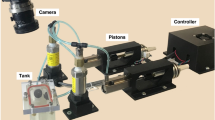Abstract
Clustered ventilation defects are a hallmark of asthma, typically seen via imaging studies during asthma attacks. The mechanisms underlying the formation of these clusters is of great interest in understanding asthma. Because the clusters vary from event to event, many researchers believe they occur due to dynamic, rather than structural, causes. To study the formation of these clusters, we formulate and analyze a lattice-based model of the lung, considering both the role of airway bistability and a mechanism for organizing the spatial structure. Within this model we show how and why the homogeneous ventilation solution becomes unstable, and under what circumstances the resulting heterogeneous solution is a clustered solution. The size of the resulting clusters is shown to arise from structure of the eigenvalues and eigenvectors of the system, admitting not only clustered solutions but also (aphysical) checkerboard solutions. We also consider the breathing efficiency of clustered solutions in severely constricted lungs, showing that stabilizing the homogeneous solution may be advantageous in some circumstances. Extensions to hexagonal and cubic lattices are also studied.










Similar content being viewed by others
References
Affonce DA, Lutchen KR (2006) New perspectives on the mechanical basis for airway hyperreactivity and airway hypersensitivity in asthma. J Appl Physiol 101:1710–1719
Anafi RC, Wilson TA (2001) Airway stability and heterogeneity in the constricted lung. J Appl Physiol 91(3):1185–1192
Bilek AM, Dee KC, Gaver DP (2003) Mechanisms of surface-tension-induced epithelial cell damage in a model of pulmonary airway reopening. J Appl Physiol 94(2):770–783
Donovan GM, Sneyd J, Tawhai MH (2012) The importance of synergy between deep inspirations and fluidization in reversing airway closure. PloS one 7(11)
Ermentrout BG, Edelstein-Keshet L (1993) Cellular automata approaches to biological modeling. J Theor Biol 160(1):97–133
Horsfield K, Dart G, Olson DE, Filley GF, Cumming G (1971) Models of the human bronchial tree. J Appl Physiol 31:207–217
Kay SS, Bilek AM, Dee KC, Gaver DP (2004) Pressure gradient, not exposure duration, determines the extent of epithelial cell damage in a model of pulmonary airway reopening. J Appl Physiol 97(1):269–276
Keener JP (1987) propagation and its failure in coupled systems of discrete excitable cells. SIAM J Appl Math 47(3):556–572
Lai-Fook SJ (1979) A continuum mechanics analysis of pulmonary vascular interdependence in isolated dog lobes. J Appl Physiol 46:419–429
Lambert RK, Wilson TA, Hyatt RE, Rodarte JR (1982) A computational model for expiratory flow. J Appl Physiol 52:44–56
Ma B, Sanderson M, Bates JHT (2013) Airway-parenchymal interdependence in the lung slice. Resp Physiol Meurobiol 185(2):211–216
Ma B, Breen B, Bates JHT (2013) Influence of parenchymal heterogeneity on airway-parenchymal interdependence. Resp Physiol Neurobiol 188(2):94–101
Ma B, Bates JHT (2014) Mechanical interactions between adjacent airways in the lung. J Appl Physiol 116:628–634
Nekorkin VI, Makarov VA, Kazantsev VB, Velarde MG (1997) Spatial disorder and pattern formation in lattices of coupled bistable elements. Phys D Nonlinear Phenom 100(3):330–342
Plahte E (2001) Pattern formation in discrete cell lattices. J Math Biol 43(5):411–445
Politi AZ, Donovan GM, Tawhai MH, Sanderson MJ, Lauzon AM, Bates JHT, Sneyd J (2010) A multiscale, spatially distributed model of asthmatic airway hyper-responsiveness. J Theor Biol 266(4):614–624
Rodriguez-Roisin R, Antoni F, Daniel N, Agusti AG, Wagner PD, Roca J (1991) Ventilation-perfusion mismatch after methacholine challenge in patients with mild bronchial asthma. Am Rev Resp Dis 144(1):88
Skander L, Porra L, Albu G, Trouillet N, Suhonen H, Peták F, Sevestre H, Suortti P, Sovijärvi A, Habre W et al (2013) Role of cellular effectors in the emergence of ventilation defects during allergic bronchoconstriction. J Appl Physiol 115(7):1057–1064
Tee GJ (1963) A novel finite-difference approximation to the biharmonic operator. Comput J 6(2):177–192
Tee GJ (2007) Eigenvectors of block circulant and alternating circulant matrices. N Z J Math 36:195–211
Tgavalekos NT, Tawhai M, Scott Harris R, Mush G, Vidal-Melo M, Venegas JG, Lutchen KR (2005) identifying airways responsible for heterogeneous ventilation and mechanical dysfunction in asthma: an image functional modeling approach. J Appl Physiol 99(6):2388–2397
Thorpe WC, Bates JHT (1997) Effect of stochastic heterogeneity on lung impedance during acute bronchoconstriction: a model analysis. J Appl Physiol 82(5):1616–1625
Tzeng Y-S, Lutchen K, Albert M (2009) The difference in ventilation heterogeneity between asthmatic and healthy subjects quantified using hyperpolarized 3he mri. J Appl Physiol 106(3):813–822
Venegas JG, Winkler T, Musch G, Vidal Melo MF, Layfield D, Tgavalekos N, Fischman AJ, Callahan RJ, Giacomo B, Scott HR (2005) Self-organized patchiness in asthma as a prelude to catastrophic shifts. Nature 434(7034):777–782
Wagner PD, Hedenstierna G, Bylin G (1987) Ventilation-perfusion inequality in chronic asthma. Am Rev Resp Dis 136(3):605–612
Wang Y, Golubitsky M (2005) Two-colour patterns of synchrony in lattice dynamical systems. Nonlinearity 18(2):631
World Health Organization (2007) Global surveillance, prevention and control of chronic respiratory diseases: a comprehensive approach
Yalcin HC, Perry SF, Ghadiali SN (2007) Influence of airway diameter and cell confluence on epithelial cell injury in an in vitro model of airway reopening. J Appl Physiol 103(5):1796–1807
Acknowledgments
The authors acknowledge the helpful comments of Claire Postlethwaite with regard to the structure of the eigenvalues and eigenvectors of the Jacobian.
Author information
Authors and Affiliations
Corresponding author
Additional information
GMD acknowledges the support of the National Institutes of Health via NHLBI HL103405.
Rights and permissions
About this article
Cite this article
Donovan, G.M., Kritter, T. Spatial pattern formation in the lung. J. Math. Biol. 70, 1119–1149 (2015). https://doi.org/10.1007/s00285-014-0792-9
Received:
Revised:
Published:
Issue Date:
DOI: https://doi.org/10.1007/s00285-014-0792-9




